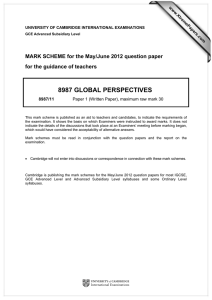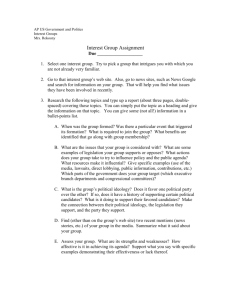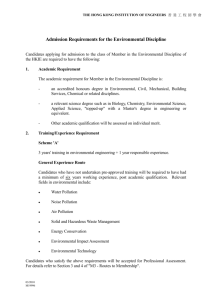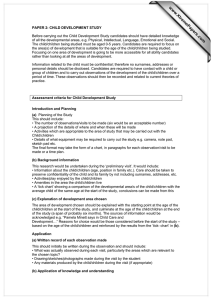8987 GLOBAL PRESPECTIVES MARK SCHEME for the October/November 2013 series
advertisement
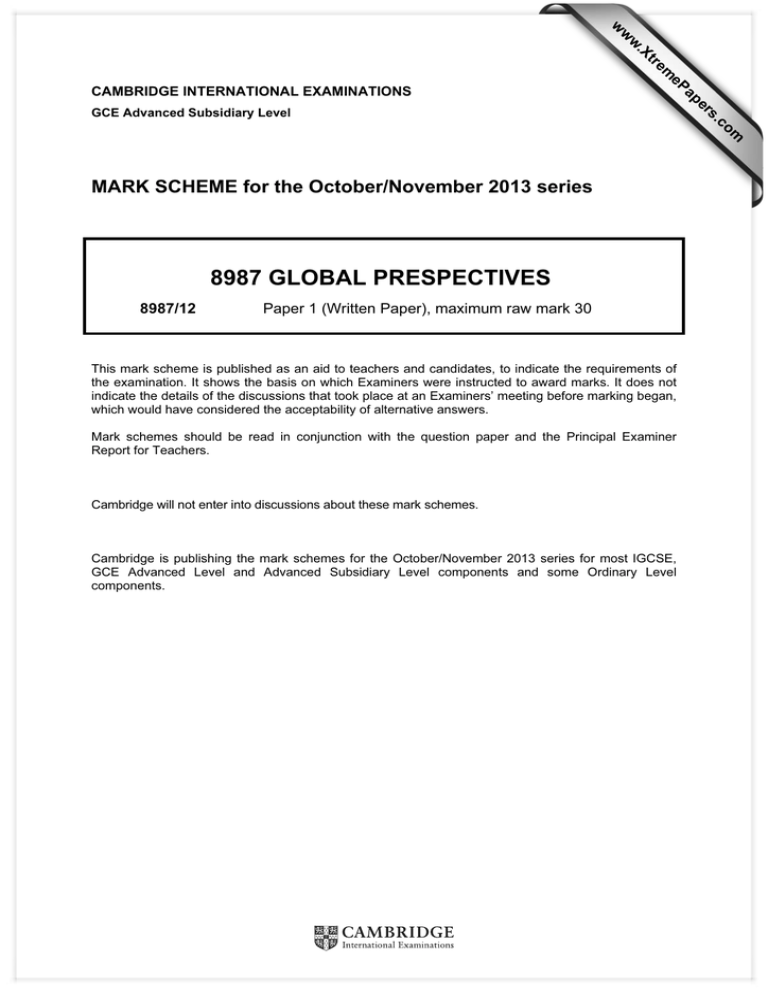
w w ap eP m e tr .X w CAMBRIDGE INTERNATIONAL EXAMINATIONS 8987 GLOBAL PRESPECTIVES 8987/12 Paper 1 (Written Paper), maximum raw mark 30 This mark scheme is published as an aid to teachers and candidates, to indicate the requirements of the examination. It shows the basis on which Examiners were instructed to award marks. It does not indicate the details of the discussions that took place at an Examiners’ meeting before marking began, which would have considered the acceptability of alternative answers. Mark schemes should be read in conjunction with the question paper and the Principal Examiner Report for Teachers. Cambridge will not enter into discussions about these mark schemes. Cambridge is publishing the mark schemes for the October/November 2013 series for most IGCSE, GCE Advanced Level and Advanced Subsidiary Level components and some Ordinary Level components. om .c MARK SCHEME for the October/November 2013 series s er GCE Advanced Subsidiary Level Page 2 Mark Scheme GCE AS LEVEL – October/November 2013 Syllabus 8987 Paper 12 Assessment Objectives AO1 Deconstruction Analyse and evaluate conclusions, argument, reasoning or claims • • • • • AO1 Reconstruction • Analyse the evidence for conclusions, arguments, reasoning or claims • • • • critically compare different perspectives analyse the structure of arguments, reasoning or claims and identify the key components evaluate the implications of the conclusions, arguments, reasoning or claims analyse and evaluate the strengths and weaknesses of arguments, reasoning or claims evaluate the validity of the conclusions, arguments, reasoning or claims research and analyse evidence to support conclusions, arguments, reasoning or claims evaluate sources used to support conclusions, arguments, reasoning or claims research and analyse alternative perspectives and conclusions against the supporting evidence identify and analyse the context upon which arguments have been based evaluate the reliability and credibility of sources © Cambridge International Examinations 2013 Page 3 1 Mark Scheme GCE AS LEVEL – October/November 2013 Syllabus 8987 Paper 12 Study Document 1. Summarise the main evidence given in Document 1 for the problem of oil pollution in Nigeria. [4] Examiners should note that this question carries only four marks and therefore candidates are not expected to write in great detail. The question asks candidates to summarise and therefore they should not be overly rewarded for copying out or quoting large amounts of text. Candidates are required to put the argument into their own words. There is no set answer to this question but candidates are likely to consider some of the following in their responses: • • • • • • • • The description of the lake. The term ‘global capital of oil pollution’ exaggerates the pollution problems. A local company was paid to clean up a leak in 2009, but as the area is still ‘an oil slick’ this shows that this was unsuccessful. Lack of monitoring oil spills. There is little information from companies on pollution. The owners do not tell the truth about accidents. How easy it is to access pipelines (and so do damage to them). The infrastructure is in a really poor condition. Award a maximum of 2 marks for the summary of any piece of evidence, depending upon how well it is developed or 1 mark for each piece of evidence that is briefly explained. 2 Study Document 1. Evaluate the strengths and weaknesses of the evidence given in Document 1 to support the view that that not enough is being done about oil pollution in Nigeria. [12] Responses should focus on the strengths and weaknesses of the evidence and reasoning offered in Document 1. Candidates who focus on only the strengths or weaknesses can still achieve any mark within this level depending upon the quality of the evaluation. • • • At Level 3 candidates must consider both the strengths and weaknesses and should reach a judgement. At Level 2 there is likely to be imbalance, with most of the answer focusing on the weakness of the view, although some answers may focus largely on the strengths. At Level 1 it is likely that candidates will consider only either the strengths or weaknesses. At this level candidates’ answers are likely to be descriptive in approach, particularly at the lower end, if there is evaluation it may be very generalised. © Cambridge International Examinations 2013 Page 4 Mark Scheme GCE AS LEVEL – October/November 2013 Syllabus 8987 Paper 12 Level 3 9–12 marks Sustained evaluation of strengths and weaknesses of evidence, critical assessment with explicit reference to how flaws and counter argument support the claim. Highly effective, accurate and clearly expressed explanation and reasoning; clear evidence of structured argument/discussion, with conclusions reached/explicitly stated in a cogent and convincing manner. Level 2 5–8 marks Some evaluation of strengths and weaknesses of evidence, but evaluation may focus on one aspect; assessment of flaws etc. may not link clearly to the claim. Effective and generally accurate explanation and reasoning; some evidence of structured argument/discussion; conclusions may not be explicitly stated or link directly to the analysis. Level 1 1–4 marks Little or no evaluation of strengths and weaknesses, although flaws etc. may be identified. Level of communication is limited, response may be cursory or descriptive; communication does not deal with complex subject matter. Indicative content No set answer is expected and examiners should be flexible in their approach. There is much material that candidates might consider and examiners should note that not all is required to gain maximum marks, what matters is the quality of the evaluation. Strengths: • The use of statistics within the Document, (for example ‘there were more than 7000 spills between 1970 and 2000’) which clearly exemplifies the seriousness of the problem. • The example of the explosion of Shell’s Bomo manifold on 12th May 2009 is clear and precise, making the size of the problem seem very real. • The use of the example about examining a pipeline and flow station and the reliability of the two contrasting points of view: that of the writer and of the National Secretary of the Oil and Gas Host Communities Association, presenting a balanced argument. • Evaluation of Saturday Pirri’s point of view and the effect of his impassioned description of how the oil slick has destroyed his homeland and ‘livelihood’ which clearly illustrates the extent of the problem and the fact that little has been done to alleviate it. Weaknesses: • The choice of examples and people who are quoted in the Document. This could include an exploration of how the writer undermines the comments made by the National Secretary of the Oil and Gas Host Communities Association who claims ‘Getting close is not easy …’ yet it appears to be very easy to get close to the pipelines. • The use of the statistics lacks precision and the comment ‘Environmentalists believe spills – large and small – happen at a rate of 300 every year’ is based on the beliefs of a group of people, not on facts. • Candidates may choose to evaluate the one-sided nature of the argument and how the language is used to present a very bleak picture of the pollution problem, with no sense of hope for the future. • The credibility of the sources e.g. Shell’s bias, local fishermen could also be questioned: how reliable are these views of what is being done about the oil pollution problem in Nigeria. © Cambridge International Examinations 2013 Page 5 3 Mark Scheme GCE AS LEVEL – October/November 2013 Syllabus 8987 Paper 12 Study Documents 1 and 2. To what extent does the argument in Document 2 justify a more optimistic view of the possibility of solving pollution problems than Document 1? [14] Candidates may adopt a variety of ways in which they approach this question. Candidates might consider issues such as reasoning, the evidence used and the credibility of the Documents. If candidates do approach it in this way, examiners should not expect equal weight to be given to each element, what matters is the quality of the evaluation. Responses should focus on key reasons and evidence in both documents in order to compare alternative perspectives and synthesise them in order to reach a reasoned judgement. In order to assess whether the Documents challenge or support the view in the question candidates should consider not only the content of the Documents, but critically assess the arguments put forward through a consideration of issues such s the nature of the passages, purpose and language. • • • At Level 3 candidates will reach a sustained judgement about whether the thesis in the question is justifiable. In order to do this they will have covered a significant range of issues, and evaluated them clearly. At Level 2 there will be some evaluation and comparison, but it will be either poorly developed or limited in the areas covered. At Level 1 there will be very little comparison of the passages or evaluation and candidates may simply describe the documents or identify areas of similarity and difference, with little link to the question. Level 3 11–14 marks Answers at this level will demonstrate a sustained judgement about whether the passages support the view. There will be sustained evaluation of alternative perspectives; critical assessment with explicit reference to key issues raised in the passages leading to a reasoned and sustained judgement. Highly effective, accurate and clearly expressed explanation and reasoning; clear evidence of structured argument/ discussion, with conclusions reached/explicitly stated in a cogent and convincing manner. Level 2 6–10 marks Answers at this level will be more than just a comparison of the two Documents; there will be some evaluation, but this will not be sustained and may focus on one perspective; assessment may not link key reasons and evidence clearly to the perspective or to the reasoned judgement. Effective and generally accurate explanation and reasoning; some evidence of structured argument/discussion; conclusions may not be explicitly stated or link directly to analysis. Level 1 1–5 marks Answers at this level will describe a few points and there will be little or no evaluation of perspectives, although some relevant evidence or reasons may be identified. If there is any judgement it will be unsupported or superficial. Level of communication is limited; response may be cursory or descriptive; communication does not deal with complex subject matter. © Cambridge International Examinations 2013 Page 6 Mark Scheme GCE AS LEVEL – October/November 2013 Syllabus 8987 Paper 12 Indicative content • • • • • • • • • No set answer is expected and examiners should be flexible in their approach. Document 1 focuses more on the extent of the pollution problem in Nigeria and the fact that little seems to be being done to stop it, whilst Document 2 focuses almost entirely on what China is doing to halt the huge pollution problem it has. Document 1 describes the effect that oil pollution has on the Niger Delta on the environment and on those who live in the area. The description is bleak and candidates may choose to evaluate the use of language within the extract including examples such as the descriptive opening ‘eerie black lake’, ‘cauldrons of tar’ and the effect of the list of its destructive qualities ‘It kills our fish, destroys our skin, spoils our streams, we cannot drink…’. This can be contrasted to Document 2 with the list of positive measures being taken by the Chinese authorities to combat pollution there: ‘… a possible cap on energy use and a shift away from GDP-based performance based evaluation…’ added to the other positive measures mentioned in the document. Document 2 presents a one-sided argument overall with a detailed list of all the positive measures being taken to improve China’s pollution problems. There may also be some evaluation of the two opinions given, with some exploration of their positive vision of the future and how they both come from two opposing groups: Friends of Nature and the University. There may be some exploration of the tone and language used: one is definite that things will improve: ‘The environment tax is going to happen’ whilst the other is more ‘hopeful’. There may be some exploration of the fact that the less definite quotation is used at the end of the article, leaving the reader with a slightly less positive view. Candidates should critically assess the use of examples and evidence in order to reach a judgement. It might be suggested that both Documents include a variety of facts, both present us with several different people’s opinions and are both quite balanced in terms of who is given a voice in the argument. The two concluding paragraphs may be compared: the authorial voice in Document 1 leaves us with a pessimistic view of the future for the Niger Delta, whilst Document 2 leaves us feeling more positive that China is tackling its pollution issues, using a quotation, rather than the author’s view, to influence the reader. ‘Solving’ v ‘tackling’ – it shows you can do something, but not all problems are solved. © Cambridge International Examinations 2013

